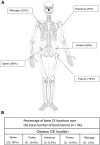Cystic Echinococcosis of the Bone: A European Multicenter Study
- PMID: 30693857
- PMCID: PMC6402919
- DOI: 10.4269/ajtmh.18-0758
Cystic Echinococcosis of the Bone: A European Multicenter Study
Abstract
Cystic echinococcosis (CE) is a zoonosis caused by the larval stage of the tapeworm Echinococcus granulosus. In humans, the infection induces the formation of parasitic cysts mostly in the liver and lungs, but virtually any organ can be affected. CE of the bone is one of the rarest forms of the disease, yet it is also extremely debilitating for patients and hard to manage for clinicians. Unlike abdominal CE, there is currently no expert consensus on the management of bone CE. In this study, we conducted a survey of the clinical records of seven European referral centers for the management of patients with CE and retrieved data on the clinical management of 32 patients with a diagnosis of bone CE. Our survey confirmed that the patients endured chronic debilitating disease with a high rate of complications (84%). We also found that diagnostic approaches were highly heterogeneous. Surgery was extensively used to treat these patients, as well as albendazole, occasionally combined with praziquantel or nitaxozanide. Treatment was curative only for two patients, with one requiring amputation of the involved bone. Our survey highlights the need to conduct systematic studies on bone CE, both retrospectively and prospectively.
Figures
References
-
- Romig T, Deplazes P, Jenkins D, Giraudoux P, Massolo A, Craig PS, Wassermann M, Takahashi K, de la Rue M, 2017. Ecology and life cycle patterns of Echinococcus species. Adv Parasitol 95: 213–314. - PubMed
-
- Polat P, Kantarci M, Alper F, Suma S, Koruyucu MB, Okur A, 2003. Hydatid disease from head to toe. Radiographics 23: 475–494; quiz 536–537. - PubMed
-
- Zlitni M, Ezzaouia K, Lebib H, Karray M, Kooli M, Mestiri M, 2001. Hydatid cyst of bone: diagnosis and treatment. World J Surg 25: 75–82. - PubMed
Publication types
MeSH terms
Substances
LinkOut - more resources
Full Text Sources
Medical


